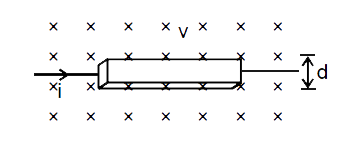The current in a copper wire is increased by increasing the potential difference between its end. Which one of the following statements regarding n, the number of charge carriers per unit volume in the wire and v the drift velocity of the charge carriers is correct -
n is unaltered but v is decreased
n is unaltered but v is increased
n is increased but v is decreased
n is increased but v is unaltered
The correct Answer is:B
To solve the question regarding the relationship between the number of charge carriers per unit volume (n) and the drift velocity (v) in a copper wire when the current is increased by increasing the potential difference, we can follow these steps:
1. Understand the Variables:
- Let n be the number of charge carriers per unit volume in the wire.
- Let vd be the drift velocity of the charge carriers.
- The current I in the wire can be expressed by the equation:
I=n⋅A⋅e⋅vd
where A is the cross-sectional area of the wire and e is the charge of an electron.
2. Identify the Effect of Increasing Potential Difference:
- When the potential difference across the wire is increased, the current I also increases.
- The charge of the electron e and the cross-sectional area A of the wire remain constant.
3. Analyze the Relationship:
- Since n (the number of charge carriers per unit volume) is a property of the material and does not change with the potential difference, we conclude that n remains constant.
- Therefore, if the current I increases while n and A are constant, the drift velocity vd must increase to maintain the equation:
I=n⋅A⋅e⋅vd
4. Conclusion:
- From the analysis, we find that:
- n is unaltered (remains constant).
- vd increases as the current increases.
- Thus, the correct statement is that n is unaltered but vd is increased.
Final Answer:
The correct option is: b) n is unaltered but v is increased.
- Let n be the number of charge carriers per unit volume in the wire.
- Let vd be the drift velocity of the charge carriers.
- The current I in the wire can be expressed by the equation:
I=n⋅A⋅e⋅vd
where A is the cross-sectional area of the wire and e is the charge of an electron.
- When the potential difference across the wire is increased, the current I also increases.
- The charge of the electron e and the cross-sectional area A of the wire remain constant.
- Since n (the number of charge carriers per unit volume) is a property of the material and does not change with the potential difference, we conclude that n remains constant.
- Therefore, if the current I increases while n and A are constant, the drift velocity vd must increase to maintain the equation:
I=n⋅A⋅e⋅vd
- From the analysis, we find that:
- n is unaltered (remains constant).
- vd increases as the current increases.
- Thus, the correct statement is that n is unaltered but vd is increased.
The correct option is: b) n is unaltered but v is increased.
Topper's Solved these Questions
Similar Questions
A current I is passed through a silver strip of width d and area of cross-section A. The number of free electrons per unit volume is n

Find the drift velocity v of the electrons.View SolutionIf the potential difference between the end of a wire of mixed resistance is doubled, by how much does the electric power increase?
View Solution
Knowledge Check
- Question 1 - Select One
In the case of forward biasing of p-n junction, which one of the following figures correctly depicts the directioin of the flow of charge carriers?
A B
B C
C DNone of these
DNone of these - Question 2 - Select One
If A is the area of cross section of conductor, e be the charge on the electrons, n be the number of electrons per unit volume and J be the current density then drift velocity of electrons is
Avd=Jn eBvd=J⋅neCvd=ne/JDvd=J2ne - Question 3 - Select One
How does the resistivity of a metal wire change if either the number of electrons per unit volume increases or the mean free time increases?
AIn both cases, the resistivity will increaseBIn both cases, the resistivity will decreaseCIncreasing the number of electrons will increase the resistivity, but it will decrease iſ the mean free timeDIncreasing the number of electrons will decrease the resistivity, but it will increase if the mean free time increases
An electric field us applied to a semiconductor.Let the number of charge carriers be n and the average drift speed be v.If the temperature is increased,
View SolutionCalculate the drift speed developed in a metal wire when V potential difference is applied across length l of the wire. The number of free electrons per unit volume is n and conductivity of the material is σ.
View SolutionA metal wire is subjected to a constant potential difference When the temperaturre of the metal in it wire increase the drift velocity of the electrons in it .
View SolutionWhen a steel wire fixed at one end is pulled by a constant force F at its other end , its length increases by l.Which of the following statements is not correct?
View SolutionThe length of an iron wire is L and area of cross-section is A. The increase in length is l on applying the force F on its two ends. Which of the statement is correct
View Solution

